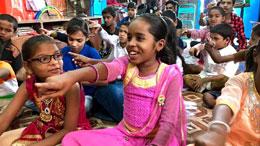Slum acting school stirs Bollywood ambitions

Teena, a 22-year-old mother, arrives late to her acting class in Dharavi, Mumbai, apologising and wiping the sweat from her forehead.
Her weekly, 10-hour round-trip from her home in Nashik to this acting school in the heart of India's biggest slum, is something of a pilgrimage.
Teena worships Bollywood, and is determined to be a star.
"I do it because I have a dream," she says, "and I will do absolutely anything for it."
The Dharavi acting school's founder and sole instructor - the moustached Babarao Laadsaheb - says Teena's dedication is shared by many.
Mumbai is home to the world's biggest film industry, and many Indians are devotees: stars' houses are treated like temples, and some fans have even built shrines for their heroes.
But the poor scarcely get a look in when it comes to starring roles: class and caste status, nepotism, fair skin, education, English language, and certain beauty ideals are at play.
Nevertheless, Bollywood "gives people hope," says Laadsaheb. "People come to this city with nowhere to live, many live on footpaths" in their pursuit of a career in cinema, he says.
Laadsaheb opened his school 35 years ago and hasn't missed a day's teaching since.
At first, he didn't charge anyone a single rupee; now, only those who can afford the classes contribute, and he covers trips to castings himself.
His biggest box-office casting to-date was Slumdog Millionaire in 2008. For some in the community, the film has become something like folklore, making a big break feel tantalisingly within reach.
Today, Laadsaheb's one-room classroom above his own home, which he built himself, is a shrine to Bollywood.
Over the years, every inch of wall space has been filled with film posters, actors' faces, and photos of Laadsaheb with celebrities.
The adults' class begins with facial exercises; every student meticulously copying Laadsaheb's expressions: elation, grief, shock.
Teena is one of two women in a class of eight.
Though Bollywood has always been male-dominated, Laadsaheb says it increasingly represents an important source of opportunity and independence for women.
"There are a lot more heroine-oriented films," he says, "and women are also getting work behind the camera."
"I feel happy when I have an audience," Teena says after class, "when people like me, when they give me recognition and appreciation."
Teena married at 16 out of material need; in the wake of her mother's death and enduring domestic violence, she had been fending for herself for years.
Her young family barely has enough money to get by, but Teena can attend the acting school for free.
"Lots of people tell me I'm wasting my time, they even tell me that I'm ruining my life.
"I feel that if I make something of myself, my family will have something to hold onto. We've had such a tough life, I want us to have pride."
She also hopes that if she becomes famous, her sister, who went missing after their mother left her father, may get in touch.
Laadsaheb tells the students, "If you have talent, you have everything."
Teena has learned that isn't always the case.
"I know I'll never get a heroine role because I know a heroine has to look a certain way," she says, "No one has to spell it out." Leading ladies in Bollywood are often tall and slim, with fair skin and long, straight hair. They are also almost always from wealthy families.
In six years of lessons and many auditions, Teena hasn't gotten any work.
"Experience has made me think that even if I give my best performance I will not be selected," she says, "They see my face and they make up their mind."









